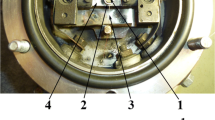Abstract
In this paper we use a macrokinetics approach to propose and develop a mechanism for the ignition and passivation of a pyrophoric nanopowder layer. Assuming that the oxidizer diffusion is the rate-limiting step in the wave-propagation mechanism of passivation, we are able to determine the dependence of the maximum temperature of the nanopowder passivation on key parameters. As a result, two-stage passivation with an increasing oxidant concentration in the gas phase at the second step is proposed. We have shown that, at an allowable warm-up level, the two-stage process reduces the time required for the passivation of a nanopowder layer to be completed by several times. The minimum time of the transition to the second stage at a given rate of temperature growth has been analytically predicted. We have also made numerical simulatons that show a good agreement with the results of our approximate calculations, additionally supporting the conclusions based on the theoretical analysis used. The macrokinetic approach is successfully applied to adeqautely described the passivation of pyrophoric nanopowders when it is strictly limited due to small particle sizes by the diffusion transfer of the passivating gas into the backfill.
Similar content being viewed by others
References
A. G. Kolmakov, S. M. Barinov, and M. I. Alymov, Principles of Technology and Application of Nanomaterials (Fizmatlit, Moscow, 2013) [in Russian].
A. Pivkina, P. Ulyanova, Y. Frolov, S. Zavyalov, and J. Schoonman, “Nanomaterials for heterogeneous combustion,” Propellants, Explos., Pyrotech. 29, 39–48 (2004).
T. M. Gorrie, P. W. Kopf, and S. Toby, “The kinetics of the reaction of some pyrophoric metals with oxygen,” J. Phys. Chem. 71, 3842–3845 (1967).
A. G. Gnedovets, A. B. Ankudinov, V. A. Zelenskii, E. P. Kovalev, M. I. Alymov, and H. Wisniewska-Weinert, “Synthesis of micron particles with Fe–Fe4N core-shell structure at low-temperature gaseous nitriding of iron powder in a stream of ammonia,” Inorg. Mater.: Appl. Res. 7, 303–309 (2016).
L. A. Zhukova and S. I. Khudyaev, “On the averaging method in calculating the exothermic reaction in a porous body-gas system,” Fiz. Goreniya Vzryva, No. 3, 47–53 (1989).
A. E. Kolovertnykh, V. B. Ulybin, S. I. Khudyaev, and A. S. Shteinberg, “To the analysis of exothermic transformation regimes in a porous layer with a diffusion supply,” Fiz. Goreniya Vzryva, No. 1, 72–79 (1982).
M. Hosokawa, K. Nogi, M. Naito, and T. Yokoyama, Nanoparticle Technology Handbook (Elsevier, Amsterdam, 2007).
M. Flannery, T. G. Desai, T. Matsoukas, S. Lotfizadeh, and M. A. Oehlschlaeger, “Passivation and stabilization of aluminum nanoparticles for energetic materials,” J. Nanomater. 2015, 185–199 (2015).
M. J. Meziani, C. E. Bunker, F. Lu, et al., “Formation and properties of stabilized aluminum nanoparticles,” ACS Appl. Mater. Interfaces 1, 703–709 (2009).
R. Nagarajan and T. A. Hatton, Nanoparticles: Synthesis, Stabilization, Passivation, and Functionalization, ACS Symposium Series (Am. Chem. Soc., Washington, DC, 2008).
M. I. Alymov, M. M. Rubtsov, B. S. Seplyarsky, V. A. Zelensky, and A. B. Ankudinov, “Temporal characteristics of ignition and combustion of iron nanopowders in the air,” Mendeleev Commun. 26, 452–454 (2016).
M. M. Rubtsov, B. S. Seplyarsky, V. A. Zelensky, and A. B. Ankudinov, “Synthesis and characterization of passivated iron nanoparticles,” Mendeleev Commun. 26, 549–551 (2016).
D. A. Frank-Kamenetskii, Diffusion and Heat Transfer in Chemical Kinetics (Plenum, New York, 1969; Nauka, Moscow, 1987).
Ya. B. Zel’dovich, G. I. Barenblatt, V. B. Librovich, and G. M. Makhviladze, Mathematical Theory of Combustion and Explosions (Nauka, Moscow, 1980; Plenum, New York, 1985).
A. G. Merzhanov, V. V. Barzykin, and V. G. Abramov, “The theory of thermal explosion from N. N. Semenov to our days,” Khim. Fiz. 15, (6), 3–44 (1996).
Author information
Authors and Affiliations
Corresponding author
Additional information
Original Russian Text © B.S. Seplyarsky, T.P. Ivleva, M.I. Alymov, 2017, published in Rossiiskie Nanotekhnologii, 2017, Vol. 12, Nos. 11–12.
Rights and permissions
About this article
Cite this article
Seplyarsky, B.S., Ivleva, T.P. & Alymov, M.I. Theoretical Analysis of Passivating Pyrophoric Nanopowders: A Macrokinetics Approach. Nanotechnol Russia 12, 583–588 (2017). https://doi.org/10.1134/S1995078017060088
Received:
Accepted:
Published:
Issue Date:
DOI: https://doi.org/10.1134/S1995078017060088




